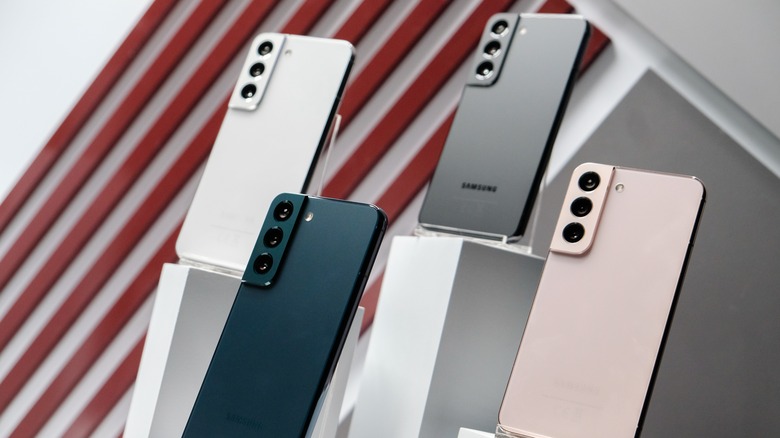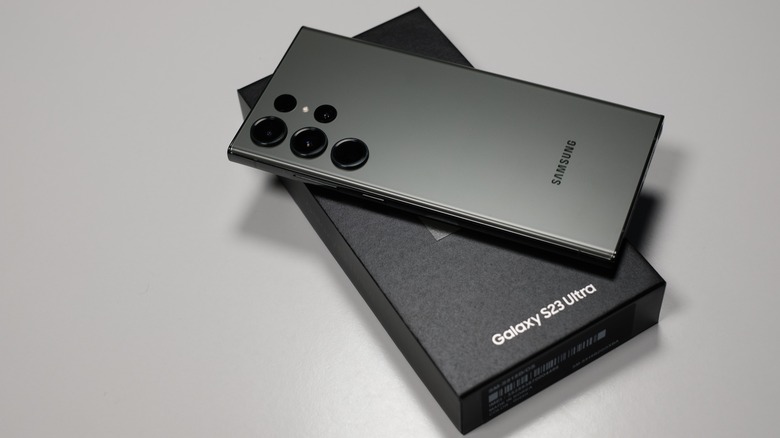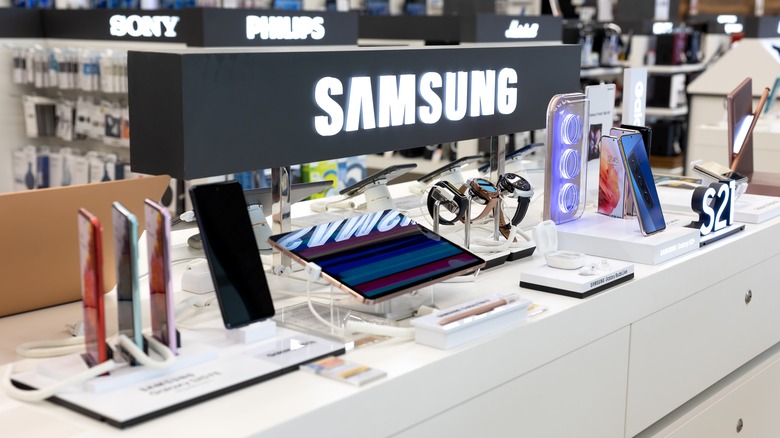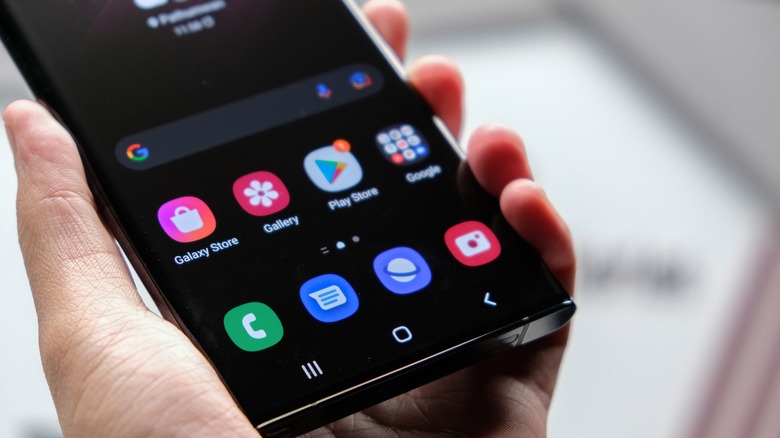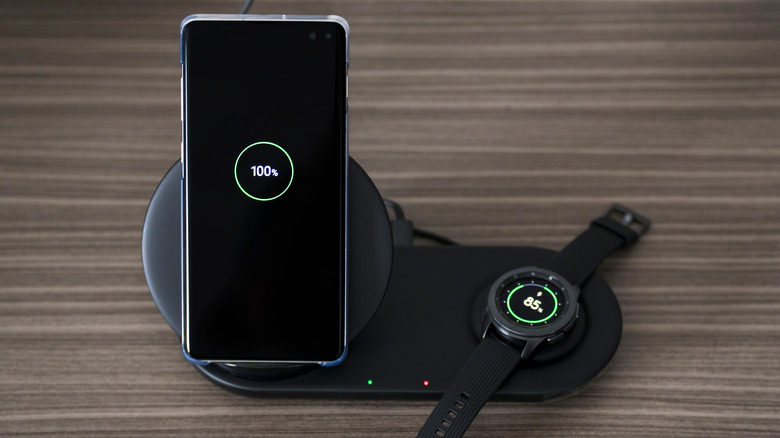5 Features That Make Samsung Galaxy Phones The Android Flagships To Beat
Among Android phone builders, the consensus has long held that Samsung is the industry standard bearer. Samsung phones go above and beyond the typical quality and functionality that can be found in a run-of-the-mill Android system. Across the brand's range (from the most inexpensive model to Samsung's most advanced, Galaxy S23 Ultra model) phones feel robust and pack a wealth of features and value additions under the hood.
Samsung Galaxy phones are the best of the bunch for a reason. These devices are often more expensive in comparison to similar, competing models, but the slight bump in price gives users access to features that bridge a vast chasm separating the competition from Samsung's lineup. From intuitive charging and battery efficiency to the very experience of dealing with Samsung versus another brand's sales and after-market support services, the South Korean titan of home and personal electronics is a clear winner in this space. These are just some of the plethora of features that set Samsung apart from the rest when it comes to Android phones.
Build quality
First up is the obvious physical characteristics of Samsung's beautiful build quality. Samsung phones have long been sleek, modern, and substantial (without becoming overbearing) in the hand. The Galaxy range has consistently paired these subtle design elements with rugged durability and high-quality materials. Samsung devices are often hailed as some of the best-built phones in the marketplace. Glass faces on both sides of the device have often been standard for Samsung, and on the recent S22 models, the Galaxy phones utilized Samsung's "Armor Aluminum" to create a frame that purportedly offers a notable 10% improvement in durability. This innovation has also found its way into the new folding devices that meld modern technology and user expectations with the vintage flipper aesthetic.
There's a lot to say about the build of Samsung Galaxy phones, but this isn't the whole story when it comes to the assembly of these fantastic devices. Not only do Samsung phones hold up to a battering of wear and tear, but Samsung support is also reportedly much easier to deal with than those from other major Android makers in the event of a fault in the device or breakage. Samsung's customer service is routinely friendly and helpful, no matter what kind of trouble you might be facing with the phone.
Interoperability of wearables and peripheral devices
While Google may have been developing eyewear and other peripheral devices before Samsung's first Galaxy Watch was released, Samsung's Galaxy Watch lineup and Galaxy Buds offerings are excellent peripheral devices in their own right. Samsung dominates the Android phone marketplace, and when paired with these additional devices the Samsung platform truly shines. A Samsung user can enjoy truly seamless connectivity and interoperability between their related devices on a greater scale than is likely achievable with any other branded devices.
The Galaxy Wearable app powers these connections that Samsung calls the Galaxy Ecosystem. With the Galaxy Watch on your wrist, you can control your phone's camera, opening up the potential to stage distant photos and snap the perfect shot. Your devices can message and enable voice connections across platforms, from your watch to your tablet. Similarly, charging your Galaxy Buds can be accomplished by just placing the case on the back of your Galaxy phone. These potent external functions make the Galaxy lineup far more of an ecosystem, rather than just a phone and its connected devices.
Samsung's One UI expands on what the Android system can accomplish
All Android phones build a 'skin' into the interface. This is the forward-facing environment that you'll interact with every time you pick up your phone to make a call or launch an app. Samsung's particular build, the One UI, is one of the most feature-rich Android skins available. Samsung has built a wealth of essential productivity and efficiency features into its Galaxy phones that transform what the devices can accomplish for both power users and light browsers alike.
One UI was introduced in 2018 and provides users with a hefty package of Samsung apps that all work pretty well on their own (things like the calling system, clock, and contacts pages). In addition, Samsung owners are able to use the Samsung DeX feature that's found within the Galaxy build. DeX gives you the ability to connect your smartphone to a screen (or smart TV), mouse, and keyboard to create a desktop feel with just your Galaxy phone. Furthermore, Samsung Galaxy users get four years of supported updates through the One UI inclusion, a marked improvement over competitors' offerings.
Relentless battery life is standard among Samsung models
Samsung Galaxy devices incorporate excellent battery technology. In comparison to the iPhone 14 (offering a 3,279 mAh battery pack), the standard Galaxy S23 model provides a 3,900 mAh capacity, and up to 5,000 in the Ultra build. Similarly, when compared to Apple's standard 20W charging and 30-watt fast charging (when supported), Samsung's newest 45-watt offering sets the tone for what's typically possible from a high-end smartphone like the Galaxy S23 Plus and S23 Ultra. Standard charging maxes out at 25 watts in other models, but still, a quality bar that ensures added extra hours of usage time in just a few minutes of connected charging time.
Others, like Motorola, are bringing fast charging to the table (up to a 125-watt rating depending on region) that dwarfs Samsung's speed. This is certainly a knock against the manufacturer, to say the least. However, with 15W wireless charging support, Samsung places itself among the top tier in terms of speed in that regard. As well, Samsung's power-saving mode is tailored to your individual usage. Turning off apps that you don't use very often and directing power to the utilities you need can produce a battery lifespan that extends to days at a time.
Lastly, some Galaxy users can recharge their Galaxy Buds by setting them on the phone through the use of Samsung's Wireless PowerShare feature. This also gives Galaxy users the ability to transfer battery charge to another phone — for instance, when trying to organize Uber rides home at the end of a long day out on the town.
The Knox security integrations are top of the line
Finally, Samsung Galaxy phones incorporate Knox security features that are so powerful that government and enterprise clients rely on these systems to protect their assets. Samsung Knox has been used to encrypt data on Samsung Galaxy devices since 2013 and Samsung reports that it's currently used to manage over 50 million devices every day. Recent additions to the lineup utilize the Knox Vault feature, as well. This security tool protects your most sensitive data by combining Secure Memory and a Secure Processor which result in a tamper-resistant security service right in the palm of your hand.
The Knox installation allows for rock-solid biometric access, Samsung Pass (a service that protects login credentials), and a privacy dashboard that provides you with active monitoring capabilities for your device and installed apps. Securing your phone is a crucial function that any Android user must prioritize. The Knox service that underpins Samsung Galaxy devices makes this essential task a simple process that doesn't have to take up any of your active time if you don't want it to.
